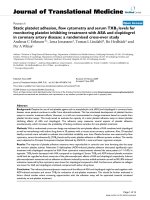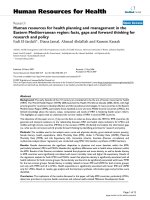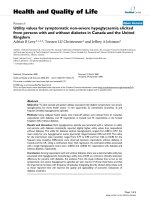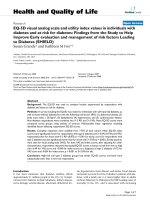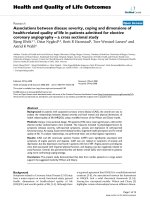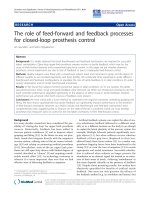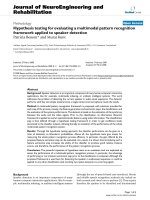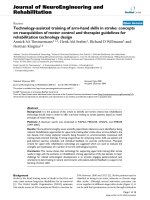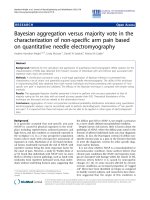Báo cáo hóa học: " Bayesian filtering for indoor localization and tracking in wireless sensor networks" docx
Bạn đang xem bản rút gọn của tài liệu. Xem và tải ngay bản đầy đủ của tài liệu tại đây (745.48 KB, 40 trang )
This Provisional PDF corresponds to the article as it appeared upon acceptance. Fully formatted
PDF and full text (HTML) versions will be made available soon.
Bayesian filtering for indoor localization and tracking in wireless sensor
networks
EURASIP Journal on Wireless Communications and Networking 2012,
2012:21 doi:10.1186/1687-1499-2012-21
Anup Dhital ()
Pau Closas ()
Carles Fernandez-Prades ()
ISSN 1687-1499
Article type Research
Submission date 28 December 2010
Acceptance date 19 January 2012
Publication date 19 January 2012
Article URL />This peer-reviewed article was published immediately upon acceptance. It can be downloaded,
printed and distributed freely for any purposes (see copyright notice below).
For information about publishing your research in EURASIP WCN go to
/>For information about other SpringerOpen publications go to
EURASIP Journal on Wireless
Communications and
Networking
© 2012 Dhital et al. ; licensee Springer.
This is an open access article distributed under the terms of the Creative Commons Attribution License ( />which permits unrestricted use, distribution, and reproduction in any medium, provided the original work is properly cited.
Bayesian filtering for indoor localization and
tracking in wireless sensor networks
Anup Dhital
1,2
, Pau Closas
∗3
and Carles Fern
´
andez-Prades
3
1
Universitat Polit
`
ecnica de Catalunya (UPC), Barcelona, Spain
2
Department of Geomatics Engineering, University of Calgary in Calgary,
Alberta, Canada
3
Centre Tecnol
`
ogic de Telecomunicacions de Catalunya (CTTC),
Parc Mediterrani de la Tecnologia,
Av. Carl Friedrich Gauss 7,
08860 Castelldefels, Barcelona, Spain
*Corresponding author:
Email addresses:
AD:
CF-P:
Abstract
In this article, we investigate experimentally the suitability of several Bayesian filtering techniques for
the problem of tracking a moving device by a set of wireless sensor nodes in indoor environments. In
particular, we consider a setup where a robot was equipped with an ultra-wideband (UWB) node emitting
ranging signals; this information was captured by a network of static UWB sensor nodes that were in
DRAFT
charge of range computation. With the latter, we ran, analyzed, and compared filtering techniques to
track the robot. Namely, we considered methods falling into two families: Gaussian filters and particle
filters. Results shown in the article are with real data and correspond to an experimental setup where
the wireless sensor network was deployed. Additionally, statistical analysis of the real data is provided,
reinforcing the idea that in this kind of ranging measurements, the Gaussian noise assumption does not
hold. The article also highlights the robustness of a particular filter, namely the cost-reference particle
filter, to model inaccuracies which are typical in any practical filtering algorithm.
1. Introduction
Wireless sensor networks (WSNs) enable a plethora of applications, from which localization
of moving devices appears as an appealing feature that complements (or substitutes) global
navigation satellite systems (GNSSs) based localization, especially in places where GNSS signals
are very weak, such as in indoor environments, or in situations where the portion of in-view sky
is small, such as urban areas with tall buildings.
There is extensive literature available on the topic, see for instance [1, 2] and references
therein. In the last decade, literally hundreds of research papers have been published dealing
with localization and tracking of devices surrounded by wireless sensors, a problem that can
be mathematically cast into an estimation problem of time-varying parameters, and where the
equations modeling the system are essentially nonlinear. Two main types of estimation techniques
have been considered so far: (i) centralized approaches, in which all measurements obtained by
the sensors are transmitted to a central processing unit in charge of performing the estimation (see,
e.g., [3]), and (ii) distributed estimation techniques (see [4, 5]), where each sensor is responsible
for the processing of its measurements and of data provided by neighboring sensors. Most of
the proposed solutions can be classified in the framework of Bayesian filtering, a statistical
approach that has also evolved importantly during the last few years due to its good behavior
in dynamical nonlinear systems [6, 7] and the availability of powerful computational resources
that enable their practical application. For instance, in [8] measurements were collected from
various sensors and processed in a centralized processing unit wherein a particle filter was used
to track a moving target. Moreover, [9] showed how even measurements of different types can
be incorporated into a single filtering algorithm. In [9], authors tracked moving objects using
various kinds of Bayesian filters.
From the wide range of wireless technologies available for WSNs, we focus our attention
on impulse-radio-based ultra-wideband (UWB), a technology that has a number of inherent
properties, which are well suited to sensor network applications. UWB technology not only has
a very good time-domain resolution allowing for precise localization and tracking, but also its
noise-like signal properties create little interference to other systems and are resistant to severe
multipath and jamming. In [10], authors provided an overview of the IEEE 802.15.4a standard,
which adopts UWB impulse radio to ensure robust data communications and precision ranging.
In this article, we undertake an experimental approach with commercial off-the-shelf devices,
in contrast to most contributions where controllable, computer-simulated, results are used to
assess the performance of a given method. Here, the focus was on the use of real-world data,
with its inherent inaccuracies and non-modeled effects, to test a set of localization algorithms.
This prevented distributed estimation techniques, since the sensor nodes did not allow additional,
custom signal processing, but provided real-life ranging measurements from which interesting
conclusions could be extracted, such as their non-Gaussianity nature. From an algorithmic
perspective, we analyzed a set of sequential estimation techniques that account for a priori
information of the moving device, the so-called Bayesian filters. In particular, Gaussian filters
and particle filters were studied and compared in the nonlinear setup. The former included the
well-known extended Kalman filter (EKF), and the recently proposed quadrature and cubature
Kalman-type techniques that showed a compromise between filtering performance and com-
putational complexity. The class of particle filters we investigated encompassed standard and
cost-reference particle filters (CRPFs). Another main contribution of this work is the assessment
of the robustness of these methods to non-Gaussian model distributions as well as other model
inaccuracies through the processing of real world data. Specially remarkable is the robustness
performance of the CRPF, since model assumptions are mild compared to the rest of the filtering
solutions.
The article is organized as follows. In Section 2, the experimental setup is described, including
an statistical analysis of the database. Section 3 provides an overview of Bayesian filtering
techniques, motivating the descriptions of suitable algorithms depending on the assumptions
about the distribution of measurement noise and the linearity of the measurement equation.
Section 4 presents results of the aforementioned algorithms in the experimental scenario described
in Section 2, and finally Section 5 draws some conclusions.
2. Experimental setup
The work reported in this article is related to the extensive UWB measurement campaign made
within NEWCOM++, an EU FP7 Network of Excellence [11]. The measurement campaign was
performed in an indoor environment with a network of N = 12 static UWB sensors deployed
in the area. The scenario was an office-like environment, whose floor map can be consulted
in Fig. 1. From the sensors shown in the figure, we only take into account UWB technology,
neglecting thus the deployed ZigBee sensors. In this experimental setup, a robot was moved in
a straight path along the corridor of a building. The robot took a 90
o
turn almost at the middle
of its run. So the trajectory of the robot was L-shaped, 20 m length approximately. The robot
was equipped with a number of sensors, namely UWB, ZigBee, and accelerometer measures
(see Fig. 2). As mentioned, only UWB technology is considered in this work. The UWB sensor
mounted on the robot emitted pulsed radio signals while moving on the track. The rest of 12
UWB sensors were placed around the trajectory of the robot. Range estimates provided by each
UWB sensor were recorded and later combined by the filtering algorithms for localization. The
data were taken for two cases: once by keeping the speed of the robot constant and again by
moving the robot with varying speed. The speed of the robot was controlled through commands
sent from a laptop using a Bluetooth channel. The robot was kept stationary for the initial 5 s
before it started to move. Since the trajectory of robot was totally controlled according to the
command generated by writing an algorithm which defines each movement of the robot in terms
of direction and speed, the true position of the robot at each instant could be easily obtained.
Such ground truth was estimated using a ruler located in the path (as might be observed in Fig. 2)
and carefully measuring by similar means the location of anchor nodes in the plane. Of course,
the precision of such ground truth was limited by the experimental nature of the measurement
campaign, although the procedure is valid to extract important conclusions after data processing.
With the knowledge of true position of robot and anchor nodes, the true range was obtained for
each anchor node in the sampling instants. Figure 3 shows the comparison of true and observed
ranges for anchor node seven during the full run of the robot along its trajectory. It can be
observed that the measurements are quite noisy as compared to the true ranges (i.e., departure
from the ideal line).
In this work, the tracking of a single mobile node (i.e., the robot) was considered for the
experiment. However, the experiment could be easily extended for multiple moving nodes if one
runs independent filters per robot in the case of self-positioning, or using more sophisticated data
association techniques to discern among targets [12–15]. The multiple target tracking setup is
left for future work, focusing our attention and conclusions on the case in which measurements
in [11] were recorded.
The Timedomain PulsON 220 UWB sensors [16], used for the experiment, operate with a
center frequency of 4.7 GHz and a bandwidth (10 dB radiated) of 3.2 GHz at −12.8 dB EIRP.
Pulse repetition frequency was 9.6 MHz. The measured quantity is the distance estimate between
the sensor nodes at a certain sampling rate (500 ms in our case). These sensors are interfaced via
Ethernet using the user datagram protocol (UDP) controlled from a laptop as shown in Fig. 2.
The locations of these sensor nodes were accurately measured. Note that all nodes were located
at a same height of 1.13 m, with the ceiling being at 3 m. Timedomain PulsON 220 UWB
node computed a range estimate using a proprietary time-of-arrival (TOA) estimator, whose
implementation is not public. The experiment of computing ranges between robot’s node and
the rest of nodes was performed 700 times per pair, composing the database described in [11].
Notice that some nodes were located inside neighboring rooms and hence those measurements
were in non-line-of-sight (NLOS) conditions for the whole (or part of the) trajectory of the robot.
More precisely, the measurement database is composed of (i) the accurately measured locations
of each node, which will be used as the true positions for algorithms assessment. In the sequel,
let us use x
t
= [x
t
, y
t
]
T
to denote the 2-D position of the robot at time t and r
i
= [x
i
, y
i
]
T
the
static coordinates of the i-th node; and (ii) the instantaneous range estimates from each node i
to the robot, denoted as ˆρ
i,t
. The recorded measurements are modeled as
ˆρ
i,t
= ρ
i
(x
t
) + n
i,t
, i ∈ {1, . . . , N} , (1)
with n
i,t
denoting the ranging error and ρ
i
(x
t
) x
t
−r
i
the true distance from the i-th node
to the robot at t.
The positioning problem is that of obtaining an estimate
ˆ
x
t
of robot’s position given ˆρ
i,t
and
r
i
with i ∈ { 1, . . . , N}. Many positioning algorithms could be used for such problem, as those
reported in [17]. For instance, to enumerate some of them, we could apply a nonlinear least
squares (LS) algorithm to deal with (1), such as those proposed in [18, 19]; a projection onto
convex sets, reported in [20]; a transformation of the measurements could be done to obtain
a linear equation [21], which can be straightforwardly solved by an LS, total LS or weighted
LS algorithms. The list of algorithms is obviously not limited to the latter and one might find
many contributions in the literature. Here, we are interested in those methods that sequentially
estimate the possibly time-evolving mobile position given the available measurements, as well
as previous records. This sequential procedure finds its theoretical justification within Bayesian
filtering, which is outlined in Section 3, along with some popular filtering algorithms.
2.1. Testing for normality of UWB-based distance measurements
Before delving into the use of Bayesian filters for tracking the mobile robot, it is important to
assess the degree of Gaussianity of the measures in the database. The aforementioned database
serves to test positioning algorithms, which sometimes resort to the Gaussian assumption, and
thus their performance potentially depends on the validity of such assumption.
There have been several attempts to model the indoor propagation channel for UWB trans-
missions. Particularly, a model due to [22] was proposed for the distribution of TOA estimates.
In this work, it was already seen that these errors could not be considered merely Gaussian,
but of a rather more complex nature. The latter includes multipath effect (bias) and LOS/NLOS
conditions. Recent works have reinforced this idea [23, 24].
In this section, we analyze the particular results reported in [11] using the Anderson–Darling
test, which is one of the most powerful tools to assess normality of a sample based on its
empirical distribution function [25].
In order to provide meaningful results, from a statistical point of view, a database of L
m
= 700
independent measures is considered here. In this setup, the same set of UWB anchor nodes was
used, with same locations, and L
m
range measures were recorded for each pair of connected
nodes (i, j) [11]. The Anderson–Darling test, which can be consulted in Appendix 1 and
particularized to our application, is a detector to assess whether the set of measurements from i
to j follows a normal distribution with unknown mean and variances or not. Let us denote the
probability that the test output is affirmative as P
i,j
{H
0
}, where H
0
is the hypothesis that the
sample is normally distributed.
The results can be consulted in Fig. 4 for different values of the detection probability. In
Fig. 4a, the average probability of accepting H
0
, P{H
0
} has been plotted. It is defined as
P{H
0
} =
1
n
c
i,j∈C
P
i,j
{H
0
} , (2)
where C is the subset of all nodes that are connected to others, i.e., those whose measurements
are available in the database. The dimension of C is denoted by n
c
= dim{C}. Notice that
there are pairs which are not connected, for instance due to obstacles in the propagation path.
Figure 4a also shows the maximum probability, over all nodes in C that H
0
is accepted:
P
max
{H
0
} = max
i,j∈C
P
i,j
{H
0
} . (3)
The results show that the Gaussian assumption is not realistic. Probability values below 0.15
were obtained on the average. Moreover, even in the best measures, where the Gaussianity fits
the most, probability values range from 0.582 to 0.884 depending on the significance level α.
For the sake of completeness, Fig. 4b plots the ordered values of P
i,j
{H
0
} with i, j ∈ C. From
this, we can see that the probability decays rapidly and that actually few measurements could
be classified as Gaussian with a probability larger than 0.5 even with low values of α.
As a conclusion of this subsection, we can claim that the Gaussian assumption does not
hold in general for the measurements in the database [11]. Even though in some pairs of range
measures it could be accepted, the majority of pairs failed the statistical test. Therefore, it is
expected that those filtering algorithms based on such modeling assumption should behave poorly
when compared with other techniques that can cope with non-Gaussianities or are distribution
free.
3. Bayesian filtering
The problem of interest concerns the estimation of an unobserved discrete-time random signal
in a dynamic system. The unknown is typically referred to as the state of the system. State
equation models the evolution in time of states as a discrete-time stochastic function, in general
x
t
= f
t−1
(x
t−1
, u
t
) , (4)
where f
t−1
(·) is a known, possibly nonlinear, function of the state x
t
and u
t
is referred to as
process noise which gathers any mismodeling effect or disturbances in the state characterization.
The relation between measurements and states is modeled by
y
t
= h
t
(x
t
, n
t
) , (5)
where h
t
(·) is a known, possibly nonlinear function and n
t
is referred to as measurement
noise. Both process and measurement noise are assumed with known statistics and are mutually
independent. The initial a priori distribution of the state vector is assumed to be known,
p(x
0
) p(x
0
|y
0
). From a theoretical point of view, all necessary information to infer information
of the unknown states resides in the posterior distribution.
Bayesian filtering involves the recursive estimation of states x
t
∈ R
n
x
given measurements
y
t
∈ R
n
y
at time t based on all available measurements, y
1:t
= {y
1
, . . . , y
t
}. To that aim,
we are interested in the filtering distribution p(x
t
|y
1:t
) and its recursive computation given
p(x
t−1
|y
1:t−1
), as well as p(y
t
|x
t
) and p(x
t
|x
t−1
) referred to as the likelihood and the prior
distributions, respectively. Such recursive solution is implemented in two steps, prediction and
update, each one consisting in the evaluation of integrals. The reader is referred to textbook
references for further insight into the Bayesian filtering framework [6, 26–28]. Once the filtering
distribution becomes available, one is typically interested in computing statistics from it. For
instance, the minimum mean square error (MMSE) estimator E
X|Y
{x
t
|y
1:t
}, or in general any
function of the states E
X|Y
{ϕ(x
t
)|y
1:t
}.
Unfortunately, the filtering equations involved in the Bayesian estimation can be solved ana-
lytically only in few cases such as the case of linear/Gaussian dynamic systems where the KF
yields to the optimal solution [29]. In general setups, one has to resort to suboptimal solutions,
most of them based on efficient numerical integration methods [6].
The experimental setup presented in Section 2 can be easily mapped into a dynamic system
of the form (4)–(5). For instance, a linear constant acceleration model has been adopted for state
evolution [30], and thus
x
t
y
t
˙x
t
˙y
t
x
t
=
1 0 T 0
0 1 0 T
0 0 1 0
0 0 0 1
x
t−1
f
t−1
(x
t−1
)=F
t
x
t−1
+
T
2
2
0
0
T
2
2
T 0
0 T
a
t
+ u
t
(6)
where the state vector is composed of position and velocity components, p
t
(x
t
, y
t
)
T
and
v
t
( ˙x
t
, ˙y
t
)
T
, respectively. Process noise u
t
is assumed to be a zero-mean Gaussian process, i.e.,
u
t
∼ N(0, Q), with covariance chosen to be Q = 0.1 ·I
4
hereinafter according to measurement
campaign processing. Finally, T denotes the sampling period in (6).
In (6) we have accounted for external information other than ranging. In particular, we have
considered that the robot was equipped with an inertial measurement unit (IMU) that provides
filtered estimates of acceleration of the mobile [31, 32]. Particularly, we considered the three-axis
acceleration sensor LIS3L02DQ [33]. a
t
(¨x
t
, ¨y
t
)
T
can then be modeled as the true acceleration
plus zero-mean additive Gaussian noise with a standard deviation 0.01 m/s
2
.
On the other hand, from (1), we know that measurement equation
y
t
= [ˆρ
1,t
, ··· , ˆρ
N,t
]
T
(7)
=
x
t
− r
1
.
.
.
x
t
− r
N
h
t
(x
t
)
+
n
1,t
.
.
.
n
N,t
n
t
(8)
is nonlinear. As some of the most popular Bayesian filters resort to the Gaussian assumption, we
consider that measurement noise n
t
is normally distributed according to n
t
∼ N(0, R), although
we know from Section 1 that it is not the case in general. Notice that some of the filters that will
be discussed in this article do not impose Gaussianity of noise distributions. In the simulation
results of Gaussian filters reported in Section 4, we considered that R = 4 · I
N
m
2
. This value
was obtained after off-line analysis of database measurements.
The rest of this section presents a number of filtering algorithms based on different assumptions
on the model defined by (4)–(5). Particularly, we focus our attention on the location problem
defined in Section 2, in which measurements were nonlinear and states evolved linearly.
3.1. Extended Kalman filter
The KF achieves optimal MMSE solution only under the highly constrained linear/Gaussian
conditions. However, for most real world systems, the assumptions are too tight. They may not
hold in some applications where the dependence of measurements on states is nonlinear, or
when noises cannot be considered normally distributed or zero-biased. In such situations, the
MMSE estimator is intractable and we have to resort to sub-optimal Bayesian filters. Among the
suboptimal filters, the EKF [26] has been widely used for some years. The main idea adopted
in the EKF is to linearize the state transition and/or observation equations through a Taylor-
series expansion around the mean of the relevant random variable and apply the linear KF to
this linearized model. This filter behaves poorly when the degree of nonlinearity becomes high.
Moreover, EKF involves the analytical derivation of the Jacobians which can get extremely
complicated for complex models. In our case, measurements are defined by range estimates (1)
and the Jacobian of h
t
, necessary for EKF implementation, is
∇
x
t
h
t
=
∂h
1,t
∂x
t
∂h
1,t
∂y
t
.
.
.
.
.
.
∂h
N ,t
∂x
t
∂h
N ,t
∂y
t
, (9)
where
∂h
i,t
∂x
t
=
x
t
−x
i
2x
t
−x
i
and
∂h
i,t
∂y
t
=
y
t
−y
i
2y
t
−y
i
, ∀i = 1, . . . , N.
3.2. Sigma-point Kalman filters
To overcome the drawbacks of EKF, many derivatives of KF have been proposed to date, the most
popular one being the unscented Kalman filter (UKF) [34]. UKF belongs to a family of Kalman-
like filters, called the sigma Point Kalman filters (SPKFs) [35]. SPKF addresses the issues of
EKF for nonlinear estimation problems by using the approach of numerical integration. The
dynamic system is again considered Gaussian, and thus one can identify that the prediction/update
recursion can be transformed into a numerical evaluation of the involved integrals in the Bayesian
recursion [36]. Then, only estimates of mean and covariance of predicted/update distributions are
necessary and the integrals are numerically evaluated by a minimal set of deterministically chosen
weighted sample points, called the sigma points. The nonlinear function is then approximated by
performing statistical linear regression between these points. This approach of weighted statistical
linear regression takes into account the uncertainty (i.e., probabilistic spread) of the prior random
variable. Besides UKF, various other SPKFs such as quadrature Kalman filter (QKF) [37, 38]
and cubature Kalman filter (CKF) [39] have been proposed and the choice among these filters
depending upon various factors such as the degree of nonlinearity, order of system state, required
accuracy, etc. Moreover, computationally efficient and numerically stable variants of these filters
have also been proposed by means of the square root version of QKF and CKF. Although
the former is able to provide enhanced results with respect to the CKF [40], its computational
cost is considerably larger in high-dimensional problems. Whereas the number of sigma-points
generated within the QKF increases exponentially with n
x
, the increase is linear in the CKF
case.
3.3. Standard particle filter
All of the Kalman-type filters, discussed above, are based on the assumption that the probabilistic
nature of the system is Gaussian. The performance of these filters tend to degrade when the
true density of the system is not Gaussian. With the improvement in processing power of the
computers, sequential Monte Carlo (SMC) based Bayesian filters are gaining popularity as they
intend to address the problems of nonlinear systems, which do not necessarily have a Gaussian
distribution. The term particle filtering (PF) denotes one of the algorithms in the SMC methods
family [41, 42].
As opposite to Kalman-type filters, where the posterior distribution is fully characterized by
its mean and covariance, a PF provides a discrete characterization of the distribution. The set
of N
p
weighted random points is referred to as particles
x
(i)
t
, w
(i)
t
N
p
i=1
. These random samples
are drawn from the importance density distribution, π(·),
x
(i)
t
∼ π
x
t
x
(i)
0:t−1
, y
1:t
(10)
and weighted according to
˜w
(i)
t
= w
(i)
t−1
p
y
t
x
(i)
0:t
, y
1:t−1
p
x
(i)
t
x
(i)
t−1
π
x
(i)
t
x
(i)
0:t−1
, y
1:t
. (11)
Here, we consider the standard particle filter (SPF) based on the sampling importance resam-
pling (SIR) concept [7]. In this case, π(·) = p
x
t
x
(i)
t−1
is the transitional prior and weights
can be expressed in terms of the likelihood distribution, ˜w
(i)
t
= p
y
t
x
(i)
t
. After particle
generation, weighting and normalization
w
(i)
t
= ˜w
(i)
t
/
i
˜w
(i)
t
, a MMSE estimate of the state
can be computed as
ˆ
x
t
=
N
p
i=1
w
(i)
t
x
(i)
t
, (12)
which was proved to converge a.s. to the true value if N
p
was large enough [43, 44].
A typical problem of PFs is the degeneracy of particles, where all but one weight tend to zero.
This situation causes the particle to collapse to a single state point. To avoid degeneracy, we
apply resampling, consisting in eliminating particles with low importance weights and replicating
those in high-probability regions [45, 46].
In this article, we consider a variant of the SPF, which resorts to the prior distribution to
generate particles. Such algorithm is widely used that it deserved a specific name; typically, one
refers to this implementation as the bootstrap filter. Particle generation and filtering is
x
(i)
t
∼ N
x
(i)
t−1
, Q
(13)
w
(i)
t
∝ N
h
t
x
(i)
t
, R
(14)
in this case, where we made use of the assumptions of the dynamic system described in (6)–(7).
3.4. Cost-reference particle filter
Particle filters are also sensitive to the proper specifications of the model distributions [47]. In fact
in many situations, especially when the true noise distribution is unknown or it does not have a
proper mathematical model, it is impossible to obtain a solution in closed form and hence mostly
a Gaussian distribution is assumed for the ease of computation and to obtain tractable solution.
So, it is likely that the PFs may degrade in performance whenever the assumed distribution is
different from the true distribution.
A new type of SMC filter, known as the CRPF, was first introduced in [48]. The idea in CRPF
is to propagate the particles from one time epoch to the other based on some user-defined cost
function. This family of methods tries to overcome some limitations of general PF algorithms:
namely, the need for a tractable and realistic probabilistic model of the a priori distribution of the
state, p(x
0
), the conditional density of the transition, p(x
t
|x
t−1
) and the likelihood distribution
p(y
t
|x
t
). In order to surmount such problems, CRPF methods perform the dynamic optimization
of an arbitrary cost function, which is not necessarily tied to the statistics of the state and the
observation processes, instead of relying on a probabilistic model of the dynamic system (in
contrast to the SPF algorithm). By a proper selection of this cost function, we can design and
implement algorithms in a quite simple manner, regardless of the availability of process and
measurement noise densities.
The CRPF algorithm can be interpreted as follows. Firstly, N
p
particles are randomly initialized
at t = 0. Usually, one draws from a uniform distribution in the bounded interval I
x
0
, and a zero
cost is assigned to each particle:
x
(i)
0
∼ U(I
x
0
) (15)
C
(i)
0
= 0 , (16)
for i = 1, . . . , N
p
. Notice that in the CRPF algorithm, we denote as particles the set
x
(i)
t
, C
(i)
t
N
p
i=1
.
At t + 1, particles with higher cost are selected (by resampling) and those with lower cost are
rejected. The cost of the selected particles does not change in this stage. Preserving the cost of
particles after resampling helps to shift particles toward local minima of the cost function. The
predictive cost of the particle, defined as
R
(i)
t+1
= λC
(i)
t
+ R
x
(i)
t
|y
t+1
, (17)
is calculated for each particle. We use the following risk function
R
x
(i)
t
|y
t+1
=
y
t+1
− h
t
f
t
x
(i)
t
q
, (18)
where q ≥ 1 and ||b|| =
√
b
T
b denote the norm of b. Then, a probability mass function (PMF)
of the form
ˆπ
(i)
t+1
∝ µ
R
(i)
t+1
(19)
is defined, where µ : R → [0, +∞] is a monotonically decreasing function, known as the
generating function. The most intuitive choice of PMF is
µ
R
(i)
t
= 1/R
(i)
t
, (20)
which we adopt in the sequel. Then, we resample the trajectories
x
(i)
t
, C
(i)
t
N
p
i=1
according to
ˆπ
t+1
and obtain a new set
ˆ
x
(i)
t
,
ˆ
C
(i)
t
N
p
i=1
.
The following algorithmic step is particle propagation. First, a set of N
p
random particles are
drawn from an arbitrary conditional distribution, p
t+1
(x
t+1
|x
t
), with only constraint being that
E
p
t+1
(x
t+1
|x
t
)
{x
t+1
} = f
t
(x
t
). These new particles have associated weights
C
(i)
t+1
= λ
ˆ
C
(i)
t
+ ∆C
(i)
t+1
, (21)
where, λ, which lies between 0 and 1, is the forgetting factor that controls the weights assigned
to old observations. ∆C
(i)
t+1
is the incremental cost function. An intuitive and computationally
simple choice [49] is
∆C
(i)
t+1
=
y
t+1
− h
t
x
(i)
t+1
q
, (22)
where q ≥ 1. The updated set of particles is then
x
(i)
t+1
, C
(i)
t+1
N
p
i=1
, which is used for estimation
purposes as follows. As in the selection step, a PMF is once again defined:
π
(i)
t+1
∝ µ
C
(i)
t+1
, (23)
from which several estimators can be computed, including the minimum cost estimator. In this
paper, we are interested in the mean estimate
ˆ
x
t+1
=
N
p
i=1
π
(i)
t+1
x
(i)
t+1
, (24)
which reminds of the estimator in (12) for the SPF algorithm.
4. Results
The Bayesian filters introduced in Section 3 were used to track and locate the robot of the
experimental setup in Section 2. Recall that a robot was moved along a trajectory while emitting
an UWB ranging signal; such signal was received by a set of UWB sensors located in an office
environment with known locations. The problem tackled in this article is that of a data fusion
center in charge of tracking the position of the robot accounting for the measured ranges. Initial
position ambiguity was modeled with a Gaussian random variable with covariance 10 · I
2
Figure 5 shows the cumulative density function (CDF) of the localization error for various
filters. Also, a solution based on the LS algorithm applied to the observations in (7) was evaluated
for the sake of comparison. Note that this is not a sequential method. Particularly, we considered
N
p
= 50 particles for both SPF and CRPF algorithms, as well as q = 2 for the cost function
in CRPF. The plot shows the probability that a certain filter occurs in an error lower than the
selected x-axis value. Therefore, a good filter in terms of such figure of merit is one which
tends quickly to 1, meaning that small errors were committed. Notice that it is a monotonically
increasing function. From the results in Fig. 5 we can see that, when applying the filters to
the real data in [11], the best performance was obtained by the CRPF. As predicted by theory,
the Gaussian assumption made by the filters proved to be inappropriate, and hence the inferior
performance.
The selection of the cost function for CRPF algorithm is known to be a design issue, which
might modify the performance of the filter. Typically, the L
q
-norm is used due to its simplicity
[50] as we considered in (18) and (22). For the results in Fig. 5 we considered the intuitive value
q = 2, but other options are possible. In Fig. 5, it can also be observed that the performances
of SPKFs are better than that of SPF. It shows that for certain applications, SPKF can be
a choice over SPF. This is especially beneficial when computational efficiency is one of the
major factors under consideration. A similar result has been observed in [51], wherein a UKF
has outperformed a SPF for the particular application of localization. Moreover, it can also be
observed that Bayesian filters have better performance as compared to the LS estimator. This
shows that using even a trivial prior information can enhance the performance, thus showing
the superiority of Bayesian filters to non-Bayesian ones. In Fig. 6, the CDF of the localization
error for three values of q can be consulted. The Euclidean norm, q = 2, obtain fair results as
shown in Fig. 5. However, the high degree of non-Gaussianity in range measures, mainly due to
the presence of a large percentage of outliers, makes it more appealing to use other values. For
instance, it is well known [52] that the sample mean (corresponding to q = 2) is less robust to
outliers than the median (q = 1). Given the relevance to our application, it was worthy to study
the effect of using different types of norms in the cost function. Moreover, we studied the use
of q = ∞. Results shown in Fig. 6 are in accordance with theory; the value q = 1 provides
the most robust result in the presence of outliers, being this choice for the cost function very
convenient in the setup reported in this article.
The convergence properties of SPF and CRPF do depend on the number of particles considered
[43]. A number of N
p
-values were also tested to evaluate its effect. Figure 7 depicts the overall
root mean square error (RMSE) for SPF and CRPF algorithms versus N
p
∈ [2, 100]. CRPF
used q = 1 in this figure. Apart from the conclusion that CRPF outperforms SPF, we can see
that increasing N
p
above ten particles did not modify the performance of both filters. The main
reason could be the high noise of measures, which prevents obtaining better estimation results
independently of N
p
.
The localization errors have been plotted with the 1.5σ and 3σ confidence intervals for LS
and CRPF filters in Fig. 8a,b, respectively. After using the same axis intervals, we can see that
the error values are much less and are well bounded in the case of CRPF as compared to that
of LS.
For the sake of completeness, the estimated trajectory of the CRPF with N
p
= 50 particles
and q = 1 is shown in Fig. 9. Also the true trajectory is plotted, which started at coordinates
(14.4, 11.1) meters. Crosses denote the location of UWB sensors, in accordance with the de-
ployment in Fig. 1.
5. Conclusions
In this article, we addressed the problem of robot localization by means of a set of UWB ranging
devices, as well as measures from acceleration sensors. In particular, we used an experimental
setup, and thus we dealt with real data. The contributions of this article are twofold. On the one
hand, we analyzed the Gaussian assumption of recorded data, which is commonly considered in
the derivation of many signal processing algorithms. After an exhaustive statistical analysis by
the Anderson–Darling test, we found out that this assumption does not hold in general. Therefore,
localization algorithms resorting to this consideration are likely to fail.
In a second part of the article, we studied a number of Bayesian filters to track the time-
evolving position of the robot. Mainly, we considered Kalman-type filters, standard PF, and a
recently proposed CRPF, which reduces considerably model assumptions on noise distributions.
From the results, with real data from the experimental setup, we saw that CRPF outperforms the
rest of the filters due to its inherent robustness against model inaccuracies. Other filters require
rather tight model assumptions, which do not hold in general.
Appendix 1
The Anderson–Darling test for normality
The aim of the test is to assess the normality of the sample composed of a set of L measured
ranges between a node i and its neighbor j. The set is defined as
ˆρ
()
i,j
L
=1
, where index
denotes a realization of the random variable (1) in the static scenario and L ≤ L
m
. This section
presents the method used to accept/reject Gaussianity of UWB range measures, based on the
Anderson–Darling statistic A
2
as proposed in [53]. A
2
statistic is known to be one of the most
powerful tools when testing normality [25]. The procedure is as follows.
First, for each (i, j) node pair, the set of ranges are sorted in ascending order
ˆρ
(1)
i,j
≤ ˆρ
(2)
i,j
≤ ··· ≤ ˆρ
(L)
i,j
(25)
and, since the hypothetic underlying normal distribution is unknown, the mean and variance are
estimated as
ˆµ =
1
L
L
=1
ˆρ
()
i,j
(26)
ˆσ
2
=
1
L −1
L
=1
ˆ
d
()
i,j
− ˆµ
2
. (27)
With Φ(·) being the standard normal CDF,
a
we use the standardized sample
ξ
()
=
ˆρ
()
i,j
− ˆµ
ˆσ
, = 1, . . . , L (28)
to compute the Anderson–Darling statistic A
2
, which is defined as:
A
2
= −
L
=1
2 −1
L
ln Φ(ξ
()
) + ln
1 −Φ(ξ
(L+1−)
)
− L . (29)
Then, the null hypothesis H
0
that the sample is normally distributed is rejected if the modified
statistic exceeds a given threshold:
A
2
∗
A
2
1 +
4
L
−
25
L
2
> γ
α
. (30)
The threshold γ
α
is fixed for a chosen level of significance α, where 0 ≤ α ≤ 1 is defined as
α = P
A
2
∗
> γ
α
| H
0
, (31)
that is, the probability of rejecting the null hypothesis while true. γ
α
can be obtained numerically
by Monte Carlo simulations or refer to the tabulated values as a function of L and α [25]. The
detection probability can then be straightforwardly computed as
P
D
= P
A
2
∗
≤ γ
α
| H
0
= 1 − α . (32)
Indeed, we are not interested in the case of L = L
m
since the Anderson–Darling test is known
to reject the null hypothesis for large sample sizes in the presence of small discrepancies, such
as outliers. Therefore, instead of testing the whole set of L
m
measurements, the approach taken
considers the random selection of L = 10 samples from the measurement set. Notice that the
test is more likely to reject H
0
when increasing L. The subset is then processed following the
above procedure, which is performed independently 700 times per each pair of nodes (i, j) and
averaged. One could use different L values with similar conclusions as those discussed in Section
1.
Endnote
a
Recall that the CDF of a normal random variable x with mean µ and variance σ
2
is Φ (x; µ, σ
2
) =
1
2
+
1
2
erf
x−µ
√
2σ
, with the error function [54] being defined as erf(x) =
2
√
π
x
0
e
−t
2
dt.
Competing interests
The authors declare that they have no competing interests
Acknowledgment
The authors would like to thank the anonymous reviewers for their constructive comments and
suggestions, which have significantly improved the quality of this work. The authors want to
acknowledge the critical contribution to the article made by their colleagues who carried out
the range measurement campaign: Davide Dardari (Universit
`
a di Bologna, UNIBO), Francesco
Sottile (Istituto Superiore Mario Boella), Javier Arribas (Centre Tecnol
`
ogic de Telecomunicacions
de Catalunya), Andrea Conti (Universit degli Studi di Ferrara), Marco Rosetti (UNIBO), Valerio
Casadei (UNIBO), Sergio Contino (UNIBO), Denis Fusconi (UNIBO), and Nicol
`
o Decarli
(UNIBO). This work has been partially supported by the European Commission in the framework
of the FP7 Network of Excellence in Wireless COMmunications NEWCOM++ (contract n.
216715) and COST Action IC0803 (RFCSET), as well as the Spanish Science and Technology
Commission TEC2008-02685/TEC (NARRA).
References
[1] A Boukerche (Ed.), Algorithms and Protocols for Wireless Sensor Networks, Ser. Wiley
Series on Parallel and Distributed Computing (Wiley–IEEE Press, Hoboken, NJ, 2008)
[2] K Yu, I Sharp, YJ Guo, Ground-Based Wireless Positioning, ser. IEEE Press Series on
Digital & Mobile Communication. (Wiley–IEEE Press, Chichester, UK, 2009)
[3] X Sheng, YH Hu, Maximum likelihood multiple-source localization using acoustic energy
measurements with wireless sensor networks. IEEE Trans. Signal Process. 53(1), 44–53
(2005)
[4] F Cattivelli, CG Lopes, AH Sayed, Diffusion recursive least-squares for distributed
estimation over adaptive networks. IEEE Trans. Signal Process. 56(5), 1865–1877 (2008)
[5] A Gasparri, F Pascucci, An interlaced extended information filter for self-localization in
sensor networks. IEEE Trans. Mobile Comput. 9(10), 1491–1504 (2010)
[6] Z Chen, Bayesian filtering: From Kalman filters to particle filters, and beyond. Adapt. Syst.
Lab. (McMaster University, Ontario, Canada, Tech. Rep. 2003)
[7] B Ristic, S Arulampalam, N Gordon, Beyond the Kalman Filter: Particle Filters for Tracking
Applications (Artech House, Boston, 2004)
[8] J Ansari, J Riihijarvi, P Mahonen, Combining Particle Filtering with Cricket System for
Indoor Localization and Tracking Services. Personal, Indoor and Mobile Radio Communi-
cations, 2007, in PIMRC 2007. IEEE 18th International Symposium on 2007, pp. 1–5
[9] V Fox, J Hightower, L Liao, D Schulz, G Borriello, Bayesian filtering for location
estimation. Pervasive Comput. IEEE. 2, 24–33 (2003)
[10] J Zhang, PV Orlik, Z Sahinoglu, AF Molisch, P Kinney, UWB systems for wireless sensor
networks. Proc. IEEE. 97(2), 313–331 (2009)
[11] D Dardari, F Sottile (Eds.), WPR.B database: Annex of Progress Report II on Advanced
Localization and positioning Techniques: Data Fusion and Applications, in Deliverable
DB.3 Annex, 216715 Newcom++ NoE, WPR.B, Dec 2009

